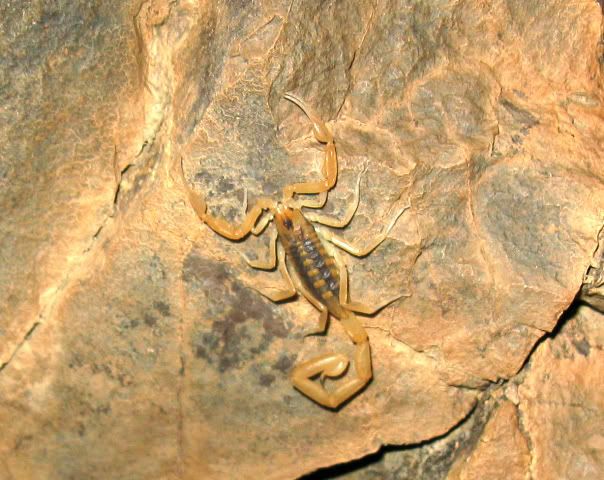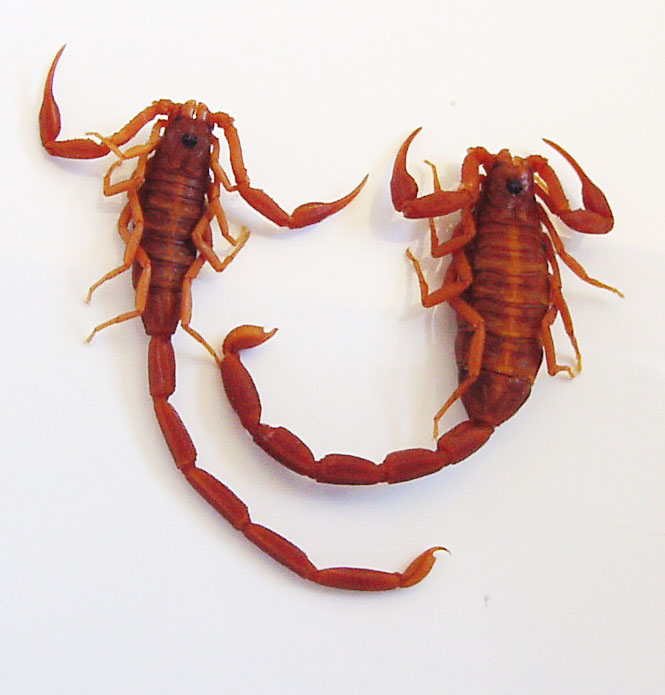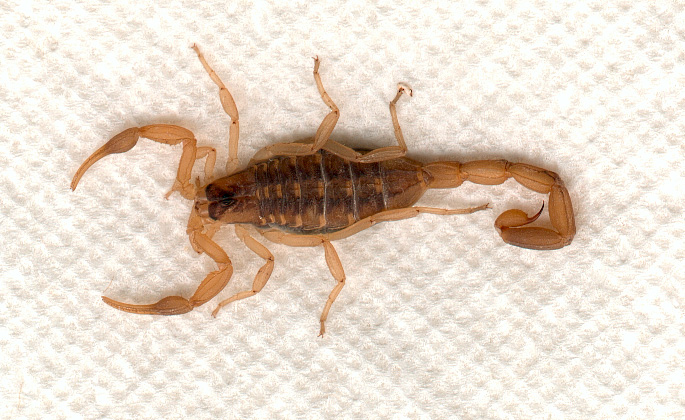

Photograph links are to sites created by Scott
Stockwell (WRBU Scorpion Emporium), Jan
Ove Rein (Scorpion Files), Warren
Savary, and R. David Gaban. Their permission, given either privately or
worded in the website, to link to their images is greatly appreciated. The
images are copyrighted by the photographers, whose rights should be respected.
Note: Some of the links to the Dr. Stockwell's photos may not work; It seems that because he is no longer directly affiliated with the Smithsonian Institution and taking care of some nasty business in Afghanistan, he has no access to keep his old Scorpion Emporium site running, and it has been dismantled. Some of his information has ben retained on the Walter Reed Vector website for scorpions. Rumor has it that Major Stockwell is currently in the Middle East, an we wish him well.
The following is an annotated checklist of the "non-vaejovid" scorpions of North America, north of Mexico. These families are the Buthidae (including the "house-dwelling" Centruroides species), Diplocentridae, Iuridae (which contains the well-known Hadrurus or giant desert hairy scorpions), and Superstitioniidae. The systematics of the American species of all but one of these families are pretty well worked out, but the zoogeography is in need of research.
Recent works attempting to revise the families and genera of scorpions have been carefully reviewed by me, some of which I consider faulty, or at least unjustified. Therefore, I follow the phylogeny as presented and debated by Prendini and Wheeler (2005) (PDF full text)
The distributions included herein are largely from published sources, Scott Stockwell's Master's Thesis, and my own collection records. Several distribution extensions are currently in manuscript form, and therefore are not included at the request of the authors.
This site is continuously under construction.
Paruroctonus/Smeringurus
Checklist
Vaejovidae
Checklist (excluding Vaejovis and Paruroctonus/Smeringurus)
The Non-Vaejovid Scorpion Taxa of The United States
Species I have collected or seen in nature are noted with an asterisk (*) in the Checklists! Compare your lists!
Classification of scorpions:
Genus Centruroides Marx, 1890. (46 species, 22 subspecies)
Distribution: Southern United States to northern South America and West
Indies.
* Centruroides
sculpturatus Ewing, 1928
 Type Locality of C. exilicauda: Lectotype (Cokendolpher & Peek 1991): Cabo San Lucas,
Baja California Sur.
Type Locality of C. exilicauda: Lectotype (Cokendolpher & Peek 1991): Cabo San Lucas,
Baja California Sur.
Type locality of C. sculpturatus: Tempe, Maricopa Co., Arizona.
Distribution: * western
New Mexico (specific
localities unpublished); Utah: along Colorado River; *
Arizona: all counties; California: rare, along Colorado River; Nevada:
southern tip.
Centruroides exilicauda: Mexico: Length of Baja
Peninsula (photo of male from northern Baja California Norte, specimen
courtesy Jim Berrian; (C)2002 KJMcWest), northern Sonora (possibly extreme
northwestern Chihuahua).
Juvenile also
from Baja, courtesy Jim Berrian, (C)2002 KJMcWest.
Notes: Centruroides sculpturatus Ewing, 1928 (Type
Locality: Tempe, Maricopa County, Arizona), and *
Centruroides
gertschi Stahnke, 1940 were considered junior synonyms for over 20 years. Recent DNA evidence
suggests that C. exilicauda and C. sculpturatus are distinct
species (Valdez-Cruz et al. 2004. Biochimie 86:387-96).
Centruroides gracilis gracilis
Type Locality: "America"
Photo at right of female C. gracilis, typical form, courtesy of
and Copyright 1999 Jan Ove Rein.
Distribution: Central to southern Florida.
Centruroides
guanensis Franganillo, 1931
Type Locality: Guane, Pinar del Rio, Cuba.
Distribution: Southern Florida, Bahamas, western Cuba. Photos of
colormorph (1) and colormorph
(2) by Dr. Rolando Teruel, Cuba.
Notes: Centruroides keysi Muma, 1967 (Type Locality: Loggerhead
Key, Monroe County, Florida), is a junior synonym (Armas, 1981b).
Centruroides
hentzi (Banks, 1900)
 Type Locality: Runnymeade, Osceola County, Florida.
Type Locality: Runnymeade, Osceola County, Florida.
Photo of preserved male (left) and female (right) from Florida, Copyright 2001
KJM & W.M. Burrell.
Distribution: Florida, southern Georgia, including
coastal islands, southeastern Alabama.
Notes: Originally described as Buthus vittatus Say, 1821.
See Stockwell, 1985, and Stockwell and Levi, 1989.
Here is a beautiful photo of
C. hentzi
by David Gaban.
* Centruroides
vittatus (Say, 1821)
 Type Locality: Neotype (Stockwell & Levi 1989): Brackettville,
Kinney County, Texas.
Type Locality: Neotype (Stockwell & Levi 1989): Brackettville,
Kinney County, Texas.
Distribution: * New Mexico: East of
the Rio Grande; Colorado: Pueblo County; Nebraska; Kansas; Missouri;
* Arkansas; Louisiana; *
Texas; Oklahoma.
Notes: Introduced populations exist in Murfreesboro, Tennessee, and
Columbia, South Carolina.
Mexico: Tamaulipas, Nuevo León, Coahuila, *
Chihuahua. Visit Dr. Stockwell's Scorpion
du Jour for interesting information on this species.
Photo of live adult female from Randall County, Texas, copyright 2001 Kari J
McWest; note shape of the carapacial markings.
Photo of live adult female from Monahans sands of Winkler County, Texas, specimen courtesy W. David Sissom.
Same female, side view; note the blue pleural membrane ("skin").
Genus Isometrus Ehrenberg, 1828
Two subgenera, 20 species, two subspecies in Asia and Australasia, except I.
maculatus, which is circumtropical.
Isometrus
maculatus (DeGeer, 1778)
Type Locality: "Suriname and Pennsylvania".
Distribution: Pantropical. Likely native to southeast Asia. Reported
from Channel Islands and Long Beach, California, Brownsville and Galveston,
Texas. Established in Hawai'i and extreme southern Florida. Surviving populations may
exist in California though it has not been reported there in recent years.
Superfamily Scorpionoidea Peters, 1862
About thirty-five genera worldwide, except Europe and Russia.
Family Diplocentridae Pocock, 1893
Two subfamiles, eight genera, 76 species (11 subspecies), distributed in North
America, Circum-Caribbean Islands, Central America, and the Middle East.
Subfamily Diplocentrinae Pocock, 1893 (seven genera)
Genus Diplocentrus Peters, 1862
34 species in Arizona, New Mexico, Texas, and widespread in Mexico, to
Belize, Guatemala, and Honduras.
* Diplocentrus diablo
Stockwell & Nilsson, 1987
Type Locality: Santa Cruz, Starr County, Texas.
Distribution: Texas: "Upper" Lower Rio Grande Valley, in
Hidalgo, Starr, and * Zapata
counties.
Mexico: Tamaulipas.
* Diplocentrus
lindo Stockwell & Baldwin, 2001
Type Locality: Sanderson, Terrell County, Texas.
Distribution: * Texas: Much of
Trans-Pecos/Big Bend Region, in Culberson, Jeff Davis, Presidio, Brewster,
Terrell, Crockett, Pecos, and Val Verde counties, possibly Reeves. Into northern *
Mexico.
Photo of live juvenile female collected in 'Texas", courtesy of R. David
Gaban, copyright 2001 Kari J McWest & W.M. Burrell.
* Diplocentrus
peloncillensis Francke, 1975
Type Locality: Geronimo Pass, Peloncillo Mountains, Hidalgo County, New
Mexico.
Distribution: Arizona: Cochise County, in Peloncillo Mountains; New
Mexico: * Hidalgo County,
Peloncillo Mountains.
Possibly in adjacent Sonora and Chihuahua, Mexico.
Notes: Pronounced "pell-own-see-YEN-sis" in reference to the
Peloncillo "pell-own-SEE-yo" Mountains along the Arizona/New Mexico
border. Photo at left Copyright 2000 R. David Gaban.
* Diplocentrus
spitzeri Stahnke, 1968
Type Locality: 8.8 mi E Nogales, Santa Cruz County, Arizona.
Distribution: Arizona: * Santa
Cruz County and adjacent Cochise County; Also in adjacent Sonora, Mexico.
Link photo from Rio Rico, AZ, Copyright 2009 KJ McWest.
* Diplocentrus whitei
(Gervais, 1844)
Type Locality: "Mexico"
Distribution: Texas: * Brewster
and * Presidio counties, in the
southern Big Bend Region.
Mexico: Chihuahua, Coahuila, and Nuevo León. Notes: Junior
synonym is Diplocentrus bigbendensis Stahnke, 1967 (Type
Locality: Grapevine Springs, Big Bend National Park, Brewster County, Texas), in Stockwell &
Nilsson, 1987.
Notes: This impressive scorpion is the largest in Texas. Photo of adult male from Presidio, Presidio County, Texas.
Superfamily Vaejovoidea Thorell, 1876 (25 genera)
Family Iuridae Thorell, 1876
Three subfamilies, six genera, 21 species, and four subspecies, distributed in
the western United States to northwestern South America, and northeastern
Mediterranean Region. This disjunct distribution is not much unlike that of
the Diplocentridae.
Subfamily Hadrurinae Stahnke, 1974
Two genera in Western North America to Central Mexico.
Genus Anuroctonus Pocock, 1893
One polymorphic species in western North America.
Anuroctonus phaiodactylus (Wood, 1863)
Type Locality: "Utah Territory".
Distribution: Nevada; California; western Utah; eastern Oregon. Possibly in western
Arizona.
Mexico: Baja California Norte.
Genus Hadrurus Thorell, 1876
Eight species from western North America to Central Mexico.
* Hadrurus arizonensis
arizonensis Ewing, 1928
Photo of female, specimen courtesy W. David Sissom.
Type Locality: Papago Saguaro National Monument, Pima County, Arizona.
Distribution: Fairly common inhabitant of the Sonoran Desert Region. Arizona:*
Gila, La Paz, * Maricopa,
Mohave, * Pima, Pinal, Yavapai, and
Yuma counties; California: Inyo, San Bernardino, Kern, Los Angeles,
Riverside, San Diego, and Imperial counties, mostly avoiding Colorado Desert
(apparently inhabited by Hadrurus arizonensis "pallidus") and westward; Nevada:
Clark and Nye counties; Utah: Garfield, Kane, and Washington counties.
Mexico: Sonora: Tiburon; Buena Vista.
Hadrurus arizonensis "pallidus" Williams, 1970
Type Locality: 26 mi E San Luis, Sonora, Mexico.
Distribution: Now a junior synonym of H. arizonensis arizonensis
(Fet, Soleglad, & Barker 2001), it is basically a color variant of the nominate
subspecies usually restricted to sandy regions. Arizona: Pima, La Paz,
and Yuma counties, from Organ Pipe Cactus National Monument to Yuma and Parker;
California: Imperial, Riverside, San Bernardino, and San Diego counties,
in Colorado Desert Subdivision of the Sonoran Desert.
Mexico: Northwestern Sonora and Baja California Norte, and Patos
Island.
* Hadrurus
obscurus Williams, 1970
Type Locality: E of Panoche, 3.5 mi W of Fresno County Line, along road
between Panoche and Mendota, San Benito County, California.
Distribution: Mojave Desert of southern and central California into
Baja California. California: * Inyo,
Kern, Fresno, San Benito, * San
Bernardino, Imperial, and Tulare counties.
Photo of adult female from California, courtesy of and Copyright (c)1996 R.
David Gaban.
*
Hadrurus spadix Stahnke, 1940
Photo of female from a Japanese website (to be linked soon).
Type Locality: (Syntypes) Yaki Trail, Cedar Ridge, Grand Canyon, Coconino
County, Wupatki National Monument, Coconino County, and Kingman, Mohave County,
Arizona.
Distribution: Arizona: * Coconino
and Mohave counties (possibly in Apache and Navajo counties). California:
Death Valley region to near I-40; Nevada; Utah; Colorado: near Grand
Junction; Idaho and Oregon in Snake River basin. Possibly
extreme northwestern New Mexico. Dr. H. L. Stahnke told me in 1979 that
he had collected specimens from near Walla Walla, Washington.
Notes: In a revision of the genus, Michael E. Soleglad noted
difficulties distinguishing between this species and Hadrurus obscurus
based on morphological characters alone. See also Fet, Soleglad, &
Barker 2001.
Family Superstitioniidae Stahnke, 1974
Four genera and nine species from Oaxaca, Mexico to southwestern United
States.
Subfamily Superstitioniinae (1 genus, 1 species)
Genus Superstitionia Stahnke, 1940
* Superstitionia
donensis Stahnke, 1940
Type Locality: Superstition Mountains, [Maricopa and Gila counties, KJM],
Arizona.
Distribution: In desert, semidesert scrub, and grasslands in: * New
Mexico (SW): (brief
mention in Williams, 1980, and Sissom, in Fet, et al., 2000; specific
localities unpublished); Arizona: Cochise and *
Greenlee counties, northwest and westward to southern Nevada
(Clark and Nye counties) to San
Benito County, California, and southward into Mexico.
In Mexico in the states of Sonora, Baja
California Norte, and Baja California Sur. Photo of live specimen from
northern BCN courtesy of Jim Berrian, San Diego Natural History Museum, (C)
KJM & WM Burrell.
Notes: Diplops desertorum Mulaik and Higgins, 1944 (Type Locality:
16 mi E Tucson, Pima County, Arizona), is a junior synonym.
Photo of preserved specimens from Catalina Mountains, Pima County, Arizona, Copyright 2001
KJM & W.M. Burrell.